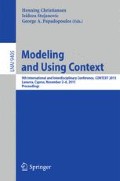Abstract
In formal languages, it is generally assumed that the symbols having the form of numbers just denote the usual mathematical numbers. In this paper, we argue that a numeric symbol is a symbol as any other and therefore may have different meanings in different contexts. Enumerating various kind of contexts in which the numeric symbols can make sense and which one, we come up with a generalized framework in which relationships between contexts, unit conversion and geometric transformations are treated in a uniform way. It also reveals the epistemological richness of what the numbers conceptually capture. Finally, this framework raises the question of contexts as types.
Access this chapter
Tax calculation will be finalised at checkout
Purchases are for personal use only
Notes
- 1.
It is worse for a number that cannot be “seen” but by writing it: here the height can be seen but can only be named through a measurement tool that produces numeric names that can then be read.
References
Baader, F., Hanschke, P.: A scheme for integrating concrete domains into concept languages. Technical Report RR-91-10, DFKI, April 1991
Caragea, D., Caragea, D., Bao, J., Bao, J., Honavar, V.G., Honavar, V.G.: Modular ontologies - a formal investigation of semantics and expressivity. In: Shi, Z.-Z., Shi, Z.-Z., Mizoguchi, R., Mizoguchi, R., Giunchiglia, F., Giunchiglia, F. (eds.) ASWC 2006. LNCS, vol. 4185, pp. 616–631. Springer, Heidelberg (2006)
Bouquet, P., Giunchiglia, F., Harmelen, F.: C-owl: Contextualizing ontologies. Technical report, Istituto Trentino di Cultura (2003)
Brewka, G., Eiter, T.: Equilibria in heterogeneous nonmonotonic multi-context systems. In: AAAI, pp. 385–390 (2007)
Dowty, D.R., Wall, R., Peters, S.: Introduction to Montague Semantics. Studies in Linguistics and Philosophy, vol. 11. Springer, Netherlands (2012)
JScience (2014). http://jscience.org
Kripke, S.A.: Semantical Considerations on Modal Logic. Naming and Necessity. Oxford University Press, Oxford (1971)
Langhaar, H.L.: Dimensional Analysis and Theory of Models. Wiley, New York (1951)
Müller, J.-P.: (2015). http://mimosa.sourceforge.net
Müller, J.-P., Rakotonirainy, H., Hervé, D.: Towards a description logic for scientific modeling. In: KEOD (2011)
International Bureau of Weights and Measures. The International System of Units (SI). Number, 8th edition. International Bureau of Weights and Measures (2006)
Schabel, M.C., Watanabe, S.: Boost unit library (2010)
Smullyan, R.M.: First-order Logic. Dover books on advanced mathematics, Dover (1995)
Acknowledgements
I would like to thank Pierre Livet for his comments. In particular he pointed the relationship between contexts and the possible operations, relating contexts to types as well as gödelization as a way to build numeric names to denote logical formulas. I would also like to thank Abdoulaye Diallo for his comments.
Author information
Authors and Affiliations
Corresponding author
Editor information
Editors and Affiliations
Rights and permissions
Copyright information
© 2015 Springer International Publishing Switzerland
About this paper
Cite this paper
Müller, JP. (2015). What the Numbers Mean? A Matter of Context!. In: Christiansen, H., Stojanovic, I., Papadopoulos, G. (eds) Modeling and Using Context. CONTEXT 2015. Lecture Notes in Computer Science(), vol 9405. Springer, Cham. https://doi.org/10.1007/978-3-319-25591-0_26
Download citation
DOI: https://doi.org/10.1007/978-3-319-25591-0_26
Published:
Publisher Name: Springer, Cham
Print ISBN: 978-3-319-25590-3
Online ISBN: 978-3-319-25591-0
eBook Packages: Computer ScienceComputer Science (R0)

